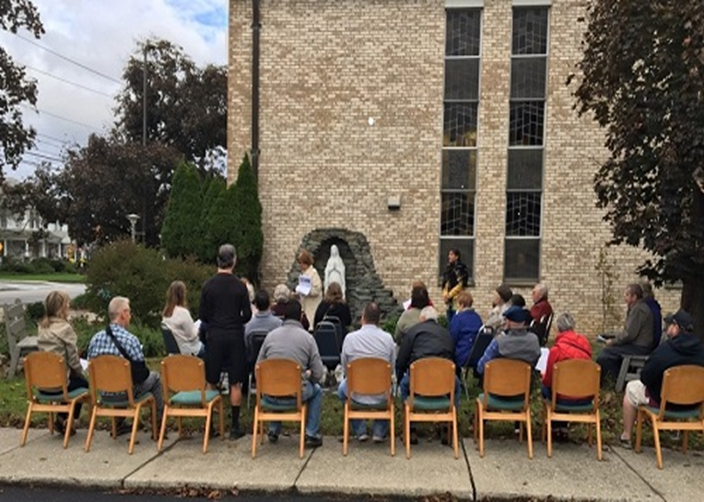Last Saturday, October 13th a devout group of parishioners organized by Joan Philip together with the Knights of Columbus held a Rosary Rally at the Grotto of the Blessed Virgin Mary outside the church at 12 noon. The Rosary was being said with the hopes that the Blessed Mother will intercede on our behalf to strengthen our Church and our country in these trying times. We would like to thank Joan Philip for initiating this graceful event and all those who participated to pray the Rosary for a worthy cause.
The Grotto was constructed approximately a year ago. And the two statues were donated by two devout parishioners. Ann Turnbull donated the stature of Our Lady of Lourdes in memory of her husband Robert Turnbull; and Arlene Corcoran donated the statue of St. Bernadette Soubirous of Lourdes in France.
As we all know, Catholics pay special attention to the Rosary during the month of October. The term, ‘Rosary’ is derived from the Latin term, “Rosarium,” meaning the garland of roses. History has shown that praying the Rosary has been one of the most powerful ways of praying. Devotion to the rosary has brought countless blessings to many since it has helped to attain peace of mind and healing. It is the experience of many that with regular recitation of the Rosary prayer, a person experiences significant improvement in their emotional health. It is because praying the Rosary helps a person to become more united with God and promotes health of mind and positive thinking.
In his apostolic letter, Rosarium Virginis Mariae (RVM), St. John Paul II called the Rosary “a path of contemplation.” It also states that though the Rosary clearly Marian in character, at heart it is a Christocentric prayer. Again RVM notes that the Rosary has all the depth of the Gospel message in its entirety. In writing this apostolic letter, St. John Paul II also added five new mysteries to the Rosary, called Luminous Mysteries. These are mysteries designated for the public life and ministry of Jesus.
How or when the Rosary began as a popular devotion cannot be pinpointed. According to tradition, the Rosary was personally delivered to St. Dominic by the Virgin Mother herself in an apparition in 1214. Although this traditional understanding is questioned by some thinkers, on the other hand the Dominicans certainly helped to standardize and popularize it throughout the fifteenth and sixteenth centuries. Since then the devotion to the Rosary has spread far and wide and become an integral part of the life of a Catholic. Then, a Dominican Pope, Pius V (1566-1572), instituted the Feast of Our Lady of the Rosary, which is now celebrated on October 7th. Also, Pope Leo XIII (1878-1903), who is known as the Rosary Pope, issued several Papal Encyclicals and Apostolic Letters on the value of the Rosary as a means of salvation.
The Rosary is a meaningful way to pray if we really pray it. It is not a good luck charm. Most of the homes of Roman Catholics have rosaries laying around their homes or hanging from the mirrors in their cars. It is hard to imagine a Catholic without a Rosary. But it is all too easy to let it turn into an unused accessory or decoration. In a fast moving high speed world, most of us need to slow down to be less stressful. When we pray the Rosary, reflectively and prayerfully, it not only calms down our bodies, but also the minds and souls.
Finally, as Pope Benedict XVI noted, “When reciting the Rosary, the important and meaningful moments of salvation history are relived. The various steps of Christ’s mission are traced. With Mary the heart is oriented toward the mystery of Jesus. Christ is put at the center of our life, of our time, of our city, through the contemplation and meditation of his holy mysteries of joy, light, sorrow and glory.”
Fr. Niranjan Rodrigo, Ph.D.
Pastor, Church of the Infant Saviour


You must be logged in to post a comment.